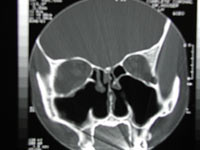| Turbinectomy/Turbinoplasty | |
|---|---|
 CT scan of the nose after total bilateral turbinectomy/turbinoplasty CT scan of the nose after total bilateral turbinectomy/turbinoplasty | |
| ICD-9-CM | 21.6 |
| [edit on Wikidata] | |
A turbinectomy or turbinoplasty (preserving the mucosal layer) is a surgical procedure, that removes tissue, and sometimes bone, of the turbinates in the nasal passage, particularly the inferior nasal concha. The procedure is usually performed to relieve nasal obstructions. In most cases, turbinate hypertrophy is accompanied by some septum deviation, so the surgery is done along with septoplasty.
Indications
A turbinectomy is usually performed to resolve turbinate hypertrophy, where the turbinates are swollen and enlarged. Common causes of this condition are allergies, environmental irritants, or a deviated septum.
Procedure
Traditional methods
There are many different techniques used in a turbinectomy, including electrocautery, cryotherapy (cryoturbinectomy), laser vaporization, and turbinoplasty. These require general anesthesia.
Radiofrequency ablation
The use of radiofrequency ablation has shown to be a safer alternative, being performed as an outpatient procedure, using lidocaine for local anesthesia. It does not alter the epithelial structure or function. It causes no postoperative pain, bleeding, or crusting, though it can result in some temporary nasal blockage or rhinorrhea due to resulting inflammation.
Complications
See also: Empty nose syndromeEmpty nose syndrome, one form of atrophic rhinitis, is a condition that can develop as a result of turbinate surgery or other surgeries that have an impact on the turbinates. It is a rare condition in which people whose nasal passages are clear following a turbinectomy experience a number of symptoms, including feelings of nasal obstruction, nasal dryness, and crusting, as well as a sensation of being unable to breathe, inter alia.
See also
References
- Ye T, Zhou B. Update on surgical management of adult inferior turbinate hypertrophy. Curr Opin Otolaryngol Head Neck Surg. 2015 Feb;23(1):29-33. PMID 25565284
- ^ Mabry, Richard L. (Jan 1988). "Inferior Turbinoplasty: Patient Selection, Technique, and Long-Term Consequences". Otolaryngology–Head and Neck Surgery. 98 (1): 60–66. doi:10.1177/019459988809800111. ISSN 0194-5998. PMID 3124053. S2CID 20931950.
- Elwany, Samy; Harrison, Robert (Jan 1990). "Inferior turbinectomy: Comparison of four techniques". The Journal of Laryngology & Otology. 104 (3): 206–209. doi:10.1017/S0022215100112290. ISSN 0022-2151. PMID 2187941. S2CID 30518285.
- Coste, André; Yona, Laurent; Blumen, Marc; Louis, Bruno; Zerah, Francoise; Rugina, Michel; Peynègre, Roger; Harf, Alain; Escudier, Estelle (May 2001). "Radiofrequency Is a Safe and Effective Treatment of Turbinate Hypertrophy". The Laryngoscope. 111 (5): 894–899. doi:10.1097/00005537-200105000-00025. ISSN 0023-852X. PMID 11359172. S2CID 40035118.
This surgery article is a stub. You can help Misplaced Pages by expanding it. |